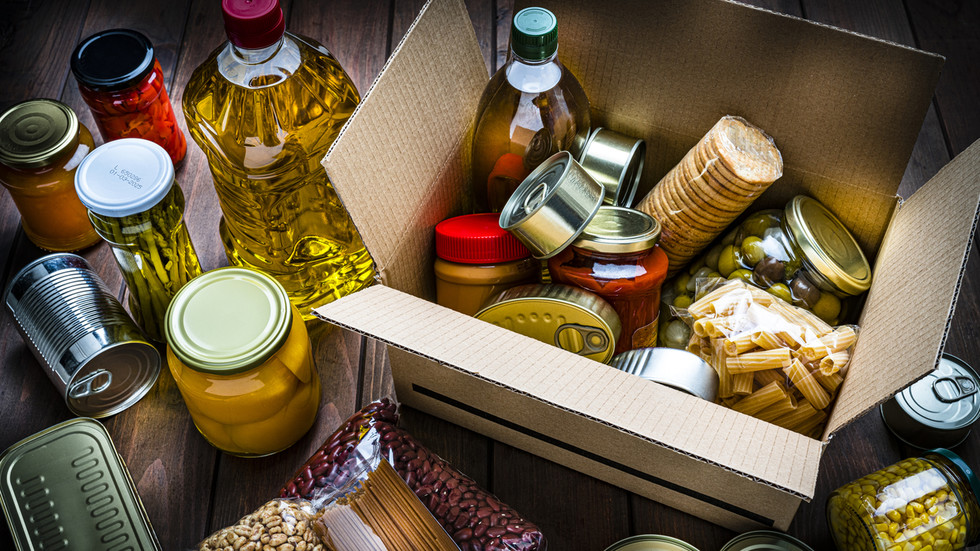Zurich is a city so busy being sustainable that the chefs don't even realise they're winning. Euronews Culture takes a jaunt to Switzerland's biggest metropolis to get the lowdown.
First appearing in the 2021 Michelin Guide, the Green Star is the pinnacle of global cuisine's recognition of sustainable practices in the restaurant world.
Establishments who earn a Green Star "hold themselves accountable for both their ethical and environmental standards, and work with sustainable producers and suppliers to avoid waste and reduce or even remove plastic and other non-recyclable materials from their supply chain," say Michelin.
It could be argued that, since most of the world's Michelin Stars are in Europe, ours is the continent that must look to innovate first, to set the bar high and inspire. And following that logic we should look to France, no? With almost twice as many stars as anywhere else in the world, one might expect France's first city, Paris, to be leading the way. And you would be very close. But there's an unlikely leader coming from neighbouring Switzerland. Take a bow, Zurich.
With a continent-topping eight Green Star restaurants in 2024, Zurich leads the way ahead of Paris (7), Copenhagen (7), and the three greenest German cities of Munich, Berlin and Hamburg who each currently have six.
Perhaps the most notable fact is...they don't know! Across Zurich, whenever I mention the fact that the city has the most Green Stars in Europe, I am met with wonder.
Even the tourist board were unaware. Am I the only one who knows? Well, not any more. And you heard it here first!
"The question of why is Zurich on the top of that list is a good question," says Vilson Krasnic, head chef of Green Star restaurant Elmira. "I have no idea why we are on that top list. I don't know. Maybe it's too early for me to understand it."
Immortalising the Radish
Krasnic shows his green flair with a dish called The Radish Carousel which uses four different types of fermented and pickle radish.
Menus change at Elmira according to the micro-seasons of the product. This awareness of seasonality coupled with the sustainable nature of their embrace of preservation (pickling, fermenting) is represented perfectly with this little dish.
It's certainly makes you aware of the wider scope of possibilities in the humble radish.
Amongst the melée is slow cooked and roasted veal tongue, but Krasnic stresses that, aside from a very popular dry aged duck dish, meat plays a secondary role at Elmira.
“We finished with vinaigrette, red cabbage juice, an organic canola oil from Switzerland and a touch of vinegar just to bring it another dimension,” he explains.
This was the first starter when the restaurant opened in 2022. From its inception the chefs applied a philosophy of 'nose to tail and root to leaf, and when it comes to meat they are committed to animal welfare. Moreover they avoid food waste by only buying the quantities needed for pre-booked menus.
But I'm interested in what sacrifices, if any, chefs need to make to qualify for a green star.
"Traditionally, if you're a chef in a high-end restaurant, you're going to say, 'you've got to have lobster'. And now maybe you don't," says Krasnic.
It seems to me that green star chefs have to really have their techniques together for them to be able to consistently offer a top level experience. I ask Krasnic about this in relation to sushi in landlocked Switzerland.
"We don't want to import fish from Japan. And we don't have to. We are doing sashimi right now with a char from Switzerland. People have the texture of a real sashimi. I mean, in Japan, they use every fish to make sashimi, but they've got a lot of fish," he elaborates. "They have their different techniques: they boil it with hot water to remove the skin, or take the skin within the sashimi, or they cut it finely, or glaze it with something. All the fishes we have here, they're edible, also raw. You just need to know how to prepare them right."
'I don't know what happened, I didn't sign anything'
Rechberg 1837 looms over me like a foreboding 19th century schoolhouse. There is no discernible plaque but it has both a Michelin Star and a Green Star.
Upon entering, the team are very young and assured. The room consists of two halves, one half a little longer and narrower than the other. Curtains act as a partition.
The music is Jazz swing, and at a well judged volume. I approve. There’s a turntable emitting gentle effulgence atop a cabinet of vinyls. A higgledy-piggledy wall cabinet showcases dog eared hardbacks and old booze. I feel quite at home.
Head chef Andi Bolliger was delighted to receive the eco-accolade but says it just happened one day.
"To be honest, I don't know exactly what it means," he admits. "Everyone says the same thing, like, I don't know what happened, I didn't sign anything. I didn't get a form through the post to fill in. Someone just turned up one day I guess."
I think Bolliger is being modest. The more he opens up about the food and the philosophy it is small wonder they achieved the green mantle, form or no form.
“Everything on our menu is born, raised, milled, picked, harvested, brewed and fermented in Switzerland,” he says. "Why have a mango from who knows where when you can have a lovely apple from a local farmer."
Limitations and Authenticity
Much like Elmira's lack of lobster, Rechberg has its limitations regarding the expected ingredients. No sea salt, coffee, pepper, or lemons. Almost everything is from Zurich's environs, one exception is rice which is brought in from Ticino, the Italian canton.
The building is indeed from 1837 and when they first opened, the idea was to use recipes from the old cookbooks they found on the premises. But it was just that bit too niche so the team had to outlive the original USP by adding more modern dishes using ingredients that may not indigenously grow in or near Zurich but were brought in to grow there.
The first course proper is, I think, a surprising choice for an opener as it's more like a home-cooked stew.
White beans are pureed and served with fermented King Oyster mushrooms, parsley, Lion’s Mane mushrooms in a broth of reduced button and shiitake mushrooms.
The beans are like mashed potato and the mushrooms are meaty and utterly delectable. This is comfort food and feels like something further down the menu but I love it. I’m left with the mushroom reduction broth and lap it up as a winter soup. This is a dish that demonstrates Bolliger's philosophy of keeping it very simple but "using a lot of the central ingredient and keep reducing."
"Use a lot of what are you doing," he clarifies. "I mean, if I'm cooking a veal gravy, I want veal and an onion. I don't want red wine. No sherry or carrots or celeriac. I just go with onions and water and bones."
The next dish is the kaleidoscopic masterpiece that adorns this article's main image: Pike ceviche with kombucha, white fish caviar, red radish, dill and diced apple.
An extremely beautiful dish that shows not only top level flavour combination but also an artistic sensibility and extraordinary elegance. It feels healthy. The crunch of the radish is the counterpoint to the raw lake fish and the dill cuttings and dill oil layer-on the umami, and that’s the element that achieves symbiosis with a very smart wine pairing of unfiltered Chasselas called 'Alloy', which I learned is the ancient name for Switzerland's most planted grape.
I poke a customary nose into the kitchen and find that Andi has promoted his apprentice to sous-chef tonight. She is remarkably unphased.
It's a tiny kitchen team of three though expertly organised through a lot of prep. There is no chaos, but Bolliger says it can be troublesome when at full capacity.
"If we're fully booked it's 35. But that's not funny. That's super, super loud. It's really a nightmare," he grimaces.
But tonight there are 22, and one large table of eight are all on the same menu, so this is perfectly manageable, I am assured.
Pasta arrives with spinach, smoked ricotta, miso sauce, nuts and winter cress (or herb Barbera as it is called here).
Bolliger thinks the Green Star revolution is here to stay.
"Michelin kind of have to do it," he says. "I think they just have to. There is no other option, especially in Europe. I don't know how it is in the US, but in Europe everything is going green and healthy, and the community is so big. It should be even more authoritative in the US, because the US is so full of bad ingredients. If there were Green Stars all over the US, that would be a wonderful thing, but then everyone would want to eat in a Michelin star and you know the cost of living there is like here."
A dish arrives that looks like a three-dimensional forest scene.
Braised and pulled goat sits amongst goat's cheese, pine, knödel (an historic German bread), garlic flowers and cassis berries.
The goat is luxurious while the capery garlic flowers are closed and full of juicy sharpness. Knödel makes it a substantial dish and the goat's cheese is necessary to provide some welcome freshness and texture.
Efforts to embrace green cuisine -- Rechberg terms itself as 'radically sustainable' -- include forging relationships with local farmers and even craftspeople. The glasses and the gorgeous cutlery are made for them by boutique Swiss manufacturers. But they also have a keen eye on the local people because you need regular custom and passing trade can fluctuate. Hence the availability of a short, three-course lunch option.
"People don't feel they have to spend 200 francs every time. And it is a lot of money," Bolliger admits. "But the overheads are quite high, particularly in Zurich. All the ingredients, they are really, really expensive. And you have to make a compromise."
A Snip Above Par
Zurich keeps trying to make me like the dreaded parsnip. I didn't expect this but it pipes up everywhere I go. Here it’s crispy parsnip with parsnip ice cream and rosemary. And it’s just lovely. What have I been eating and mostly leaving all this time? I make a note to re-examine this in 2025. It must be the year of the parsnip somewhere.
I walk across town, counting Ferraris, to Zurich's Wiedikon Rail Station. I look to my right and there sits Silex. Another Green-Starred eatery, and this one is run by a Brit.
The Sile-X Files
A rectangular room with warm lighting via mellow strips as well as the blurring tongues of candles stands before me as I am welcomed in by the friendly and spirited maitre d' who bears a passing resemblance to Gillian Anderson and also happens to be the wife of chef patron George Tomlin.
In front of me are flesh-laden amuse bouches. I get the feeling that this may be a Green Star that doesn't put meat second.
Lardo on toast shows that even the most basic plates are joyful in the right hands. The slinkiness of this lardo is mouthwatering. Making pig fat subtle is an art of breeding as well as cooking and this is a breed I have met before. The Mangalica pig not only has superior fat composition to other breeds but it is also slow to grow its intramuscular fat and thus more expensive to raise as the farmer must keep them for longer.
They are originally from Hungary but "the pig farm is only 20 minutes up the road," says Tomlin, who between extremely generous chats with me, takes on the conductor's role, front and centre in the open kitchen.
As something of a meat-admirer, I have begun to feel that Green Star restaurants, whilst being a standard bearer for cuisine that may veer more towards vegetarian dishes, could be an increasingly trustworthy refuge for responsible carnivores.
The snacks are enjoyable but the standout chomp are little fruits that look like large capers crossed with olives but are in fact cherries. Local cherries left scattered and unripe after a storm were snapped up by Chef George who decided to try something original and process them like olives, in brine for 6 months.
George’s bass baritone ‘service please’ is a delight to hear and not what I expected in Zurich. Deft, calm and assured, Tomlin has the composure of a continuity announcer, a hint of theatricality and a delightful whiff of Alan Whicker. He spent a few years in Melbourne before hitting up London’s Clove Club, which explains his twang.
I am alerted to one of the diners being something of an artisan and sure enough, Lorenzo is a sustainable food entrepreneur who grows indoor mushrooms from mycelium in Petri dishes. Some of these have made their way into Tomlin's kitchen and I am served oyster mushroom in buttermilk with roasted yeast espuma, black onions, chive and garlic oil. It is paired with my wine of the weekend, a 2022 'RheinReisling' from biodynamic grower based in the Klettgau Valley, Markus Ruch. It has an incredibly mineral nose, rather reminiscent of some artisan Jura wines I've had the pleasure to try.
The mushroom could double for hangar steak, particularly with the grilled style and seasoning. Light charring on the edges enhances this effect. This is also a very healthy portion. I want this on toast if (when) I have a hangover.
Tomlin's no-nonsense attitude to why food is good and why local producers bring authenticity is echoed by all the chefs I have been speaking to, but one gets the impression he may have become this sort of 'sustainable dude' by accident, arriving at it organically, no pun intended, because of his philosophy on food being better if you know where it comes from. But he's not after any kind of fame.
"I would be deliriously happy if I had five restaurants and nobody knew who the hell I am. That would make me super f**king happy," he says. And unlike Rechberg, there's no 'normal' Michelin star here, just the eco stamp.
"I think that Silex having a green star and no actual star, in a way, means we're special. So maybe it's a bit of justification for what we do and shit like that."
There are two tables of 10 in amongst the 70 covers. At the head of one of the large tables, quite rightly, is a man who looks like English monarch Charles I. Both groups have been getting their food on time despite some alterations being made in the kitchen for gluten intolerance and veganism.
It’s 22:30 and George allows himself a glass of wine, but by contrast I’m presented with a cider. The smell takes me back to drinking cider from a litre bottle on the Sussex downs, or in a shed, as a teenager. It’s comforting. But it's also a window onto an admirable project.
I've already sampled wine made by Markus Ruch, but in 2017 he teamed up with fellow natural winemaker Benny Oswald to rescue neglected apple and pear trees, some up to 200 years old, in their local area near the German border. The fruit these trees were producing was still top quality despite the lack of interest in them and this project very much saved them.
A celery and custard tart with double cream and pine is a cocktail of sweet and bitter and serves as a fitting finale to the cuisine of George Tomlin. His traditional British name may conjure up images of an Edwardian politician or an 18th century inventor but he is unquestionably modern. Indeed, the sheen on the celery gel is like buffed acrylic.
Should he achieve his empire it will be characterised by risk taking and dosed-up flavour combinations to thrill a table fit for a king.
Huis Clos
And as a final glance into the fabric of the Zurich scene, I was one of the lucky few diners to get a seat at the popular Maison Manesse before it closed at the end of December.
I met a team that are looking to continue their journey of sustainable cuisine into 2025 with new premises, and ideally have the kitchen on the same floor as the restaurant - "we're tired of using walkie-talkies" says maitre d' Raymond.
Austrian Chef Benjamin Plšek has a little pedigree in that he came here from a four-year stint at The Fat Duck, and I expect complexity will be a calling card.
Venison tartare with onion foam, caramelised onion and chive oil becomes one of the more robust and generous amuses bouches I’ve ever had. I could eat this in a cone.
Glazed and flamed lake Char is an artistic treat with pumpkin, tomatillo (appearance like a green lychee and used for salsa in South America), trout roe, pickled coriander seeds and some smoked paprika oil which is brought to prominence by the oxidised Slovenian Malvasia, Vinograd Fon.
It's a cross-border dish but everything is local, and though there's quite a list of ingredients, it does equate to multiple levels of flavour that all come in orchestrally at different times.
The roe, as always, provides the most enlivening texture to create a sensation around the soft, delicate fish. The fruit brings out the understated sweetness in the wine. There's real symbiosis going on here. Plšek knows what he’s doing.
Service is friendly, efficient and genuine, and once again, we find a spectacular quality of meat.
"We would never become a vegetarian restaurant because specifically plant-based is probably not our future, or at least not in our opinion. We just have to be more responsible. Okay, we see a problem with meat consumption, but the point is not then to just consume zero meat. It's to kind of find something in the middle, you know. If you are going to consume meat, it should be really good meat," says Raymond.
I’m the only one at the counter so people tend to glance across, which is fair because I’m people-watching and have already spotted a man who looks like the late English actor Michael Jayston, who I'm certain would have agreed that the food tastes smashing. Everyone is having such a good time, I wonder why are they closing.
Available staff form a guard of honour by the door as each table leaves the restaurant, which I think is a really lovely touch.
In the background, Donna Summer is singing I Feel Love and I’m definitely getting there. Not unlike the mushroom stew at Rechberg, there’s something comforting about this Tomatillo and I ponder the idea that fine dining is becoming more and more about elevated comfort than lab coat expression. Raymond agrees that Plšek has an element of high level comfort food in his cooking.
Duck legs cured and smoked, pastrami style come with mashed potato, Brussels sprouts, black kale and duck consommé with chives.
The duck is always bought whole so they can use everything. It comes from a biodynamic farm outside Zurich. It’s so warm and homely, even the extra texture element brings past comforts in the form of matchstick fries. The brightness of a still-fresh 2015 Chianti is the beautifully sour cherry on top. “I wish Sangiovese tasted like this all the time,” says Raymond. Amen.
Duck breast arrives with beetroot purée and salt baked beetroot. On another plate is a salad made from the semi-bitter Castelfranco leaf and yoghurt dressing with Szechuan oil. Over the top of that is a surprising gooseberry and duck skin granola. I think it works as an exercise in texture and temperature but the two plates are slightly jarring. However, the quality of meat once again shines through.
De-livering the Goods
Perhaps the least green foodstuff in world cuisine, and at the same time one of the most identifiably traditional fine dining ingredients is of course foie gras. This has been at the centre of this team's experiment to provide the taste without the associated negatives. But interestingly, it gave rise to a quandary.
"There was a guy in Zurich who made a vegetarian version but not a vegan version," explains Raymond. "He used to use a bit of egg protein to give it that little bit of animal product but we decided to make it totally vegan, and then we thought - what does this really mean? We all have to buy soy and we have to buy all these sorts of ersatzprodukten (replacement products) which I don't think is a solution either. On one hand, you have tonnes of meat. On the other, you have tonnes of soy. And you're like, no, they're both looking pretty crappy to me."
They throw me a sample. It's actually pretty impressive with both complexity and richness.
"It's basically nuts," confirms Plšek. "Like different fats. Coconut fat. Cacao. Butter. And we do, like, a reduction of alcohol. I wouldn't really call it foie gras, but it's a good alternative."
After a vanilla cream crepe with roasted and fermented chervil roots and a chocolate crumble with two types of quince sorbet -- paired adventurously with barrel-aged Saki that has a mellowing effect on this high acidity dessert -- it is my turn for the guard of honour. And knowing I am one of the last people to ever receive one gives me pause. Perhaps it's here that Zurich's quietly adventurous nature is best exemplified as atmosphere, attitude, skill and sustainability coincide.
The highly observant among you will have realised that, upon the closing of Maison Manesse, Zurich do not in fact have 8 green stars anymore, but you can bet your bottom Swiss Franc that they'll get it back when they find the single-floor establishment they crave.

 3 days ago
6
3 days ago
6






 We deliver critical software at unparalleled value and speed to help your business thrive
We deliver critical software at unparalleled value and speed to help your business thrive






 English (US) ·
English (US) ·